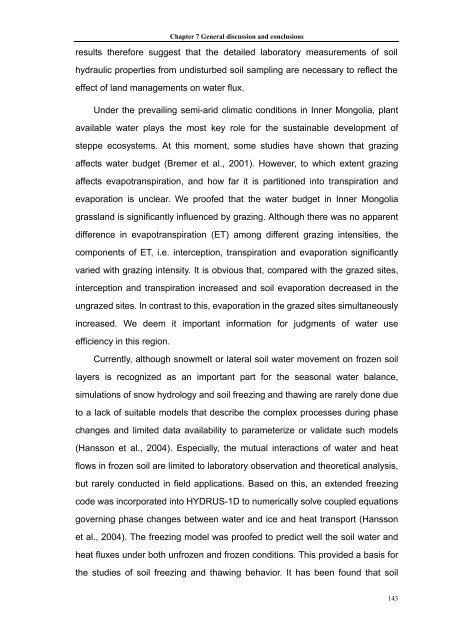SCHRIFTENREIHE Institut für Pflanzenernährung und Bodenkunde ...
SCHRIFTENREIHE Institut für Pflanzenernährung und Bodenkunde ...
SCHRIFTENREIHE Institut für Pflanzenernährung und Bodenkunde ...
You also want an ePaper? Increase the reach of your titles
YUMPU automatically turns print PDFs into web optimized ePapers that Google loves.
Chapter 7 General discussion and conclusions<br />
results therefore suggest that the detailed laboratory measurements of soil<br />
hydraulic properties from <strong>und</strong>isturbed soil sampling are necessary to reflect the<br />
effect of land managements on water flux.<br />
Under the prevailing semi-arid climatic conditions in Inner Mongolia, plant<br />
available water plays the most key role for the sustainable development of<br />
steppe ecosystems. At this moment, some studies have shown that grazing<br />
affects water budget (Bremer et al., 2001). However, to which extent grazing<br />
affects evapotranspiration, and how far it is partitioned into transpiration and<br />
evaporation is unclear. We proofed that the water budget in Inner Mongolia<br />
grassland is significantly influenced by grazing. Although there was no apparent<br />
difference in evapotranspiration (ET) among different grazing intensities, the<br />
components of ET, i.e. interception, transpiration and evaporation significantly<br />
varied with grazing intensity. It is obvious that, compared with the grazed sites,<br />
interception and transpiration increased and soil evaporation decreased in the<br />
ungrazed sites. In contrast to this, evaporation in the grazed sites simultaneously<br />
increased. We deem it important information for judgments of water use<br />
efficiency in this region.<br />
Currently, although snowmelt or lateral soil water movement on frozen soil<br />
layers is recognized as an important part for the seasonal water balance,<br />
simulations of snow hydrology and soil freezing and thawing are rarely done due<br />
to a lack of suitable models that describe the complex processes during phase<br />
changes and limited data availability to parameterize or validate such models<br />
(Hansson et al., 2004). Especially, the mutual interactions of water and heat<br />
flows in frozen soil are limited to laboratory observation and theoretical analysis,<br />
but rarely conducted in field applications. Based on this, an extended freezing<br />
code was incorporated into HYDRUS-1D to numerically solve coupled equations<br />
governing phase changes between water and ice and heat transport (Hansson<br />
et al., 2004). The freezing model was proofed to predict well the soil water and<br />
heat fluxes <strong>und</strong>er both unfrozen and frozen conditions. This provided a basis for<br />
the studies of soil freezing and thawing behavior. It has been fo<strong>und</strong> that soil<br />
143


